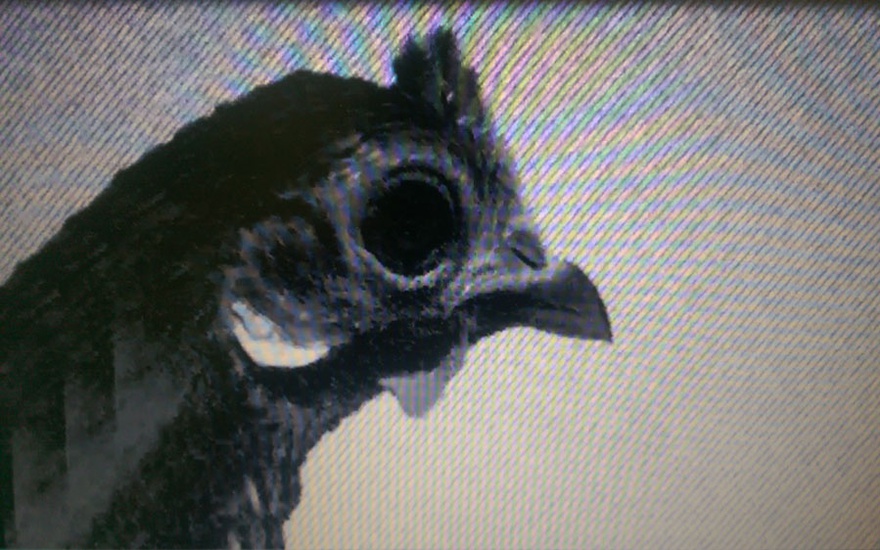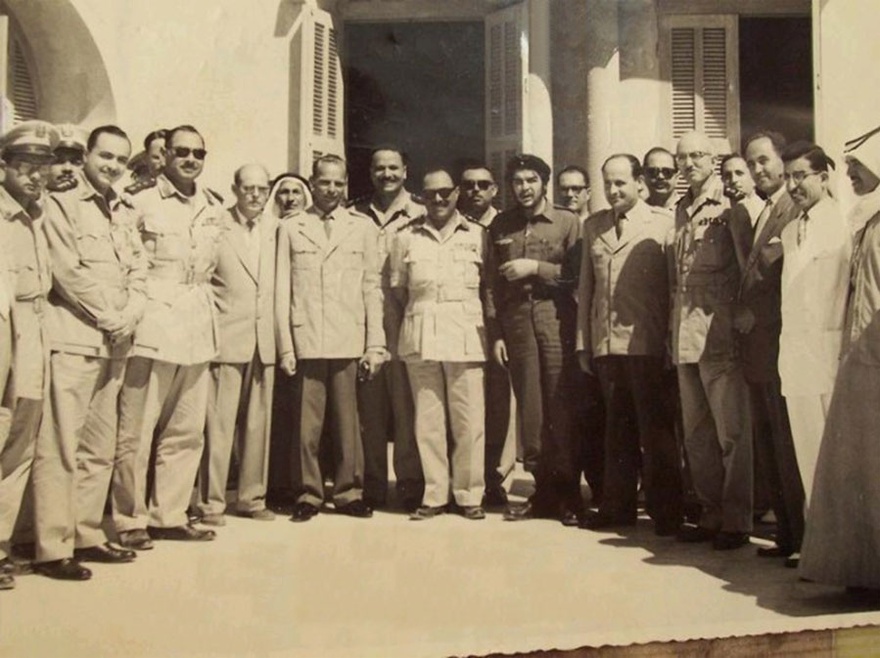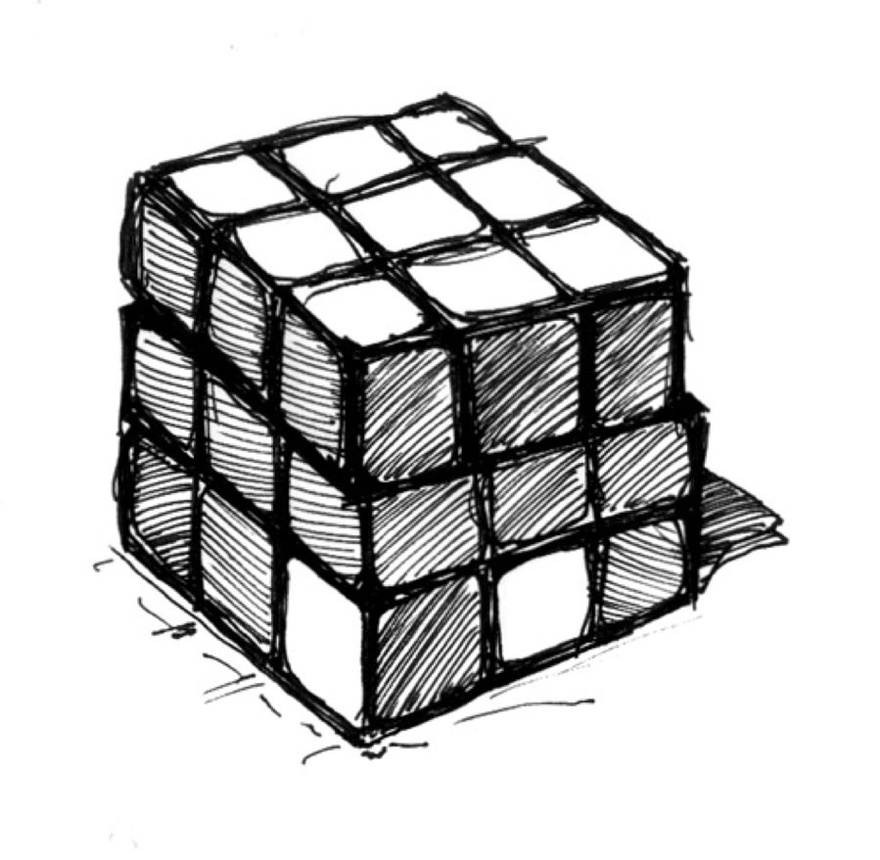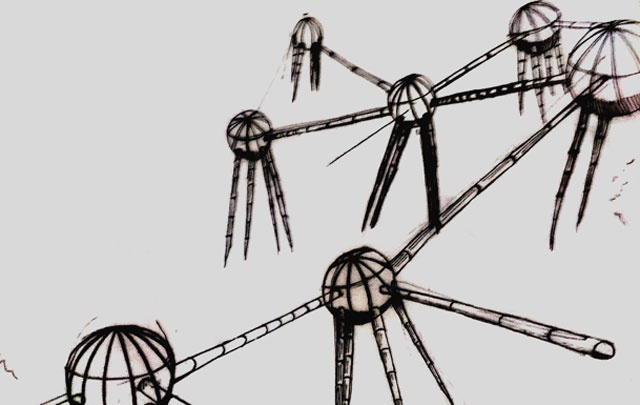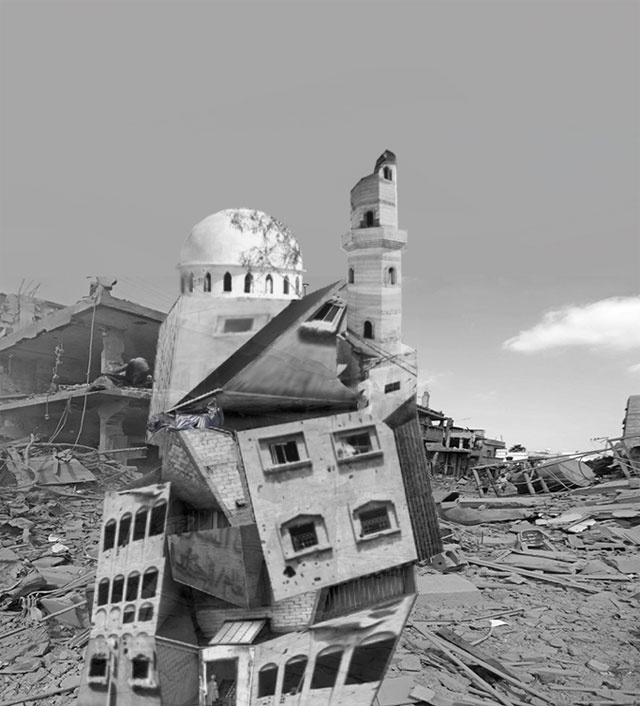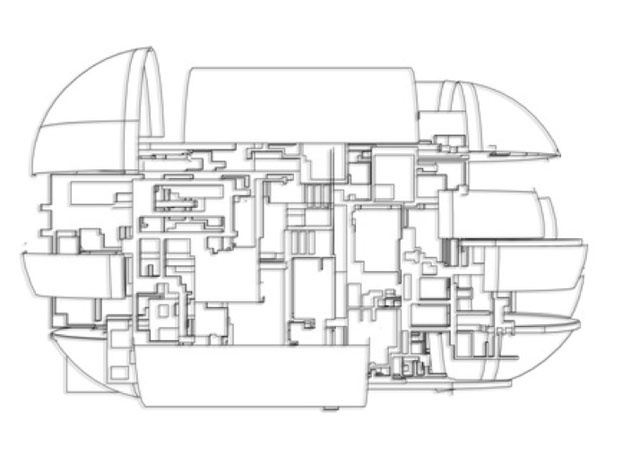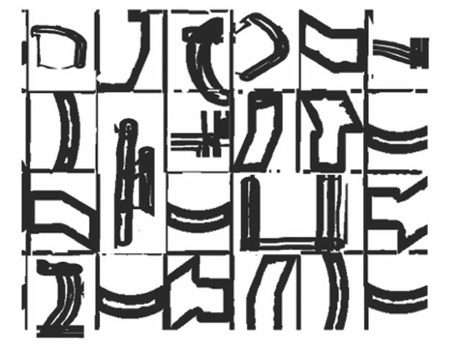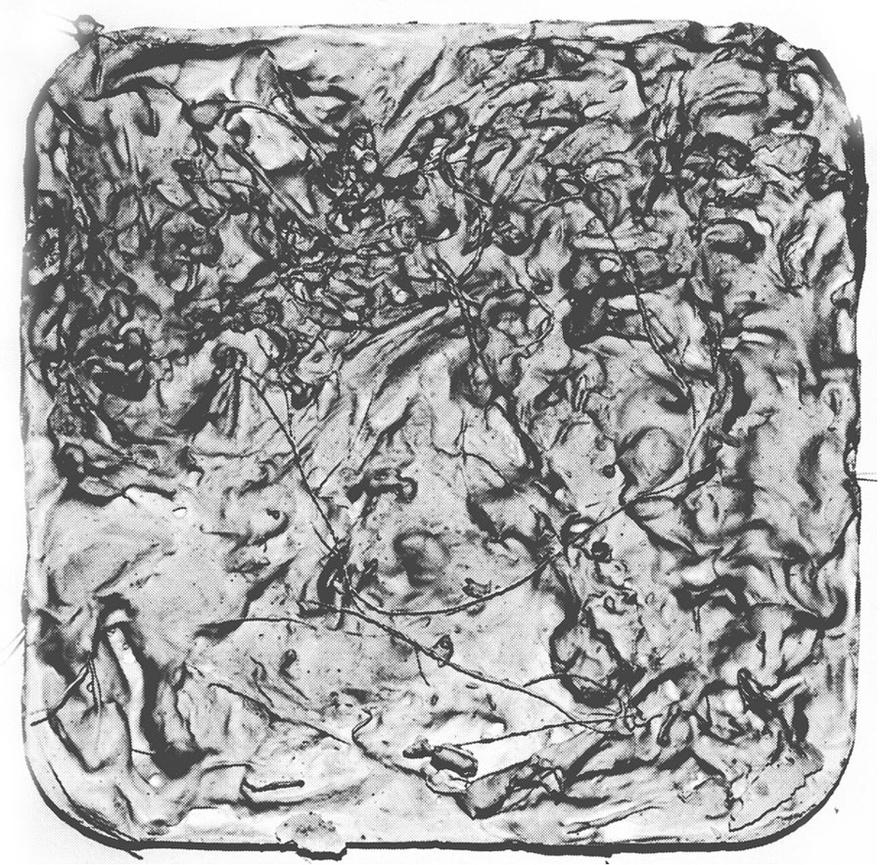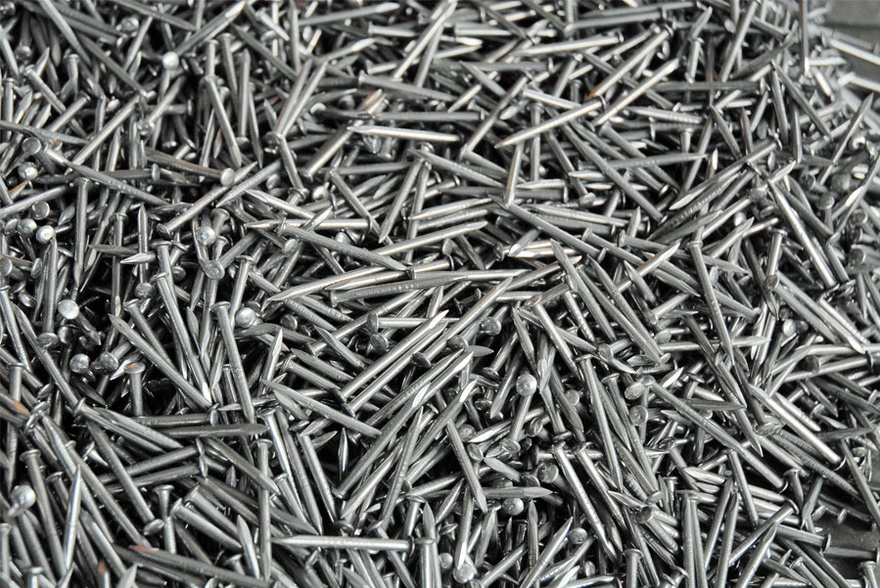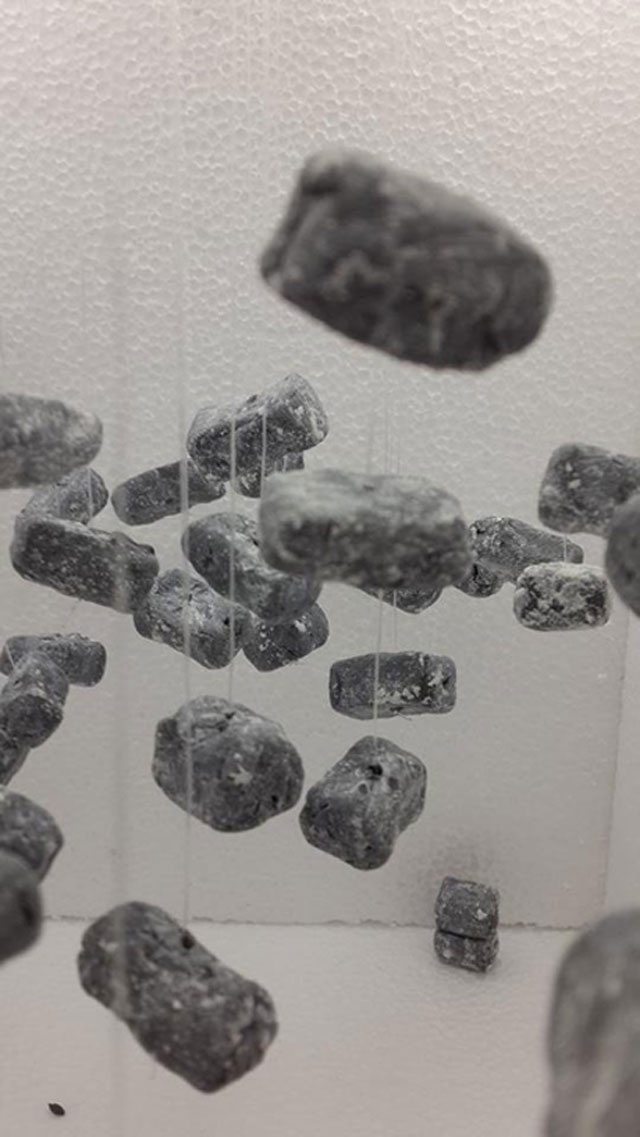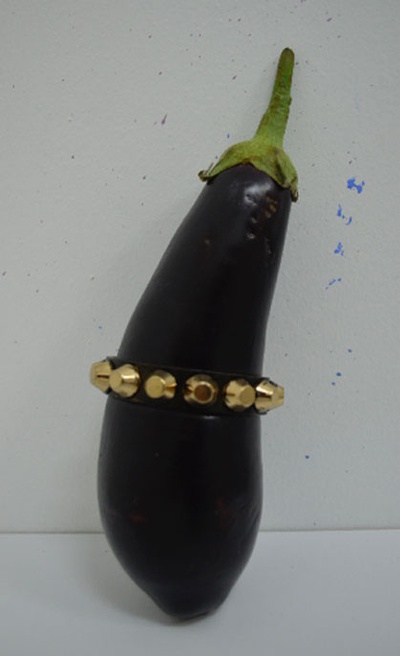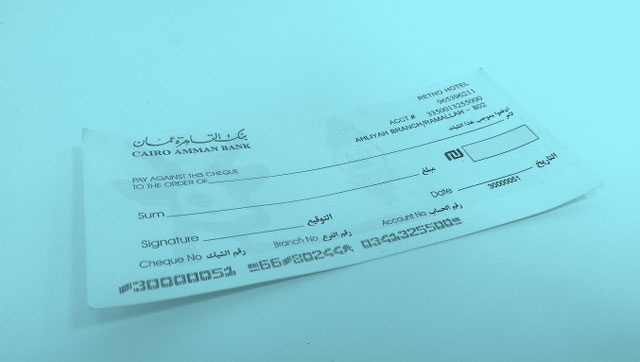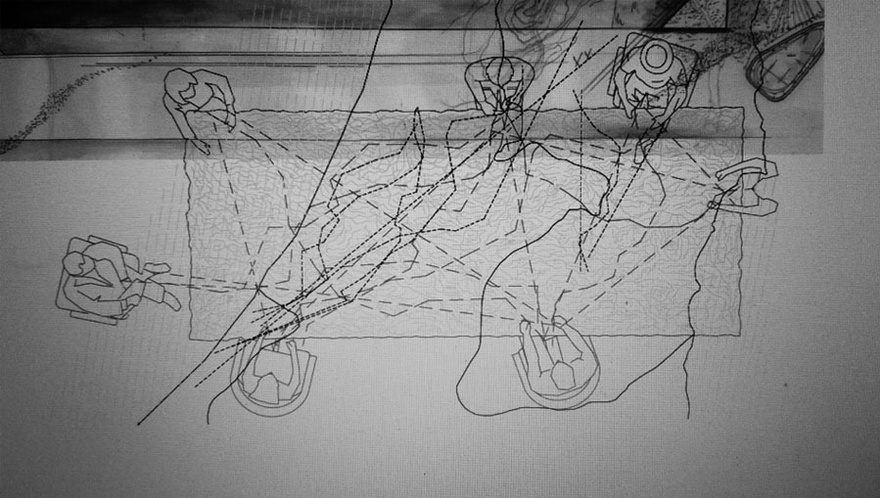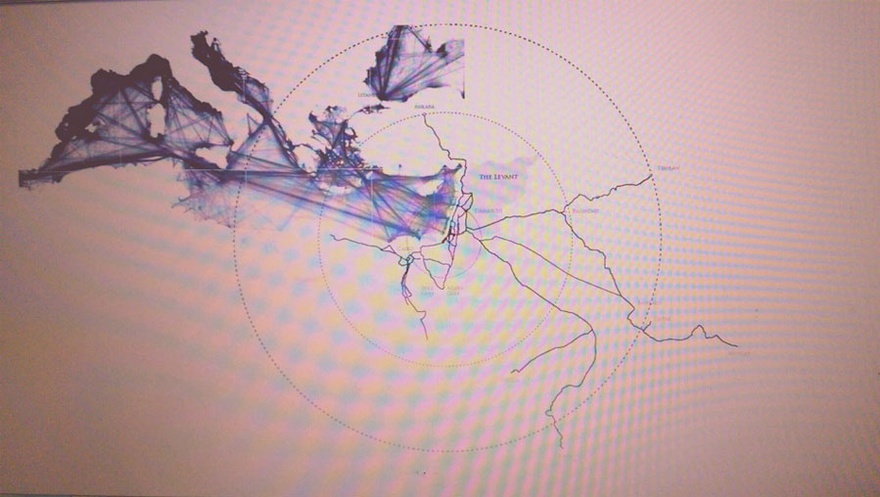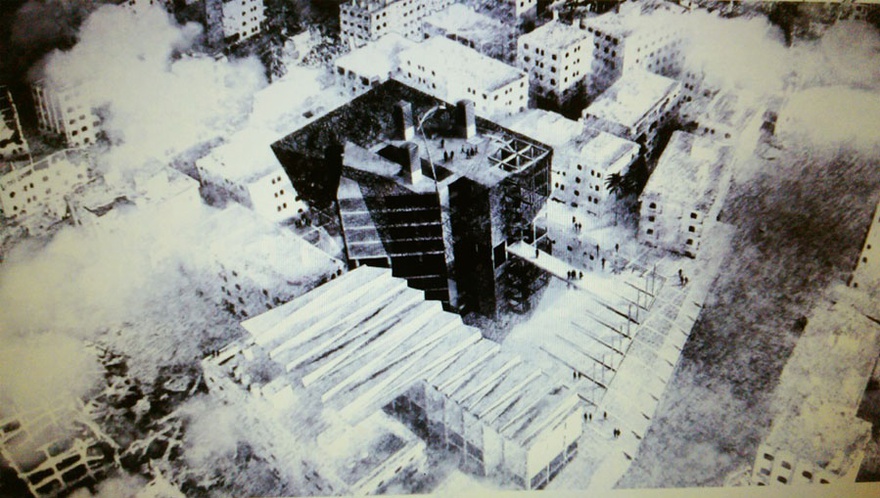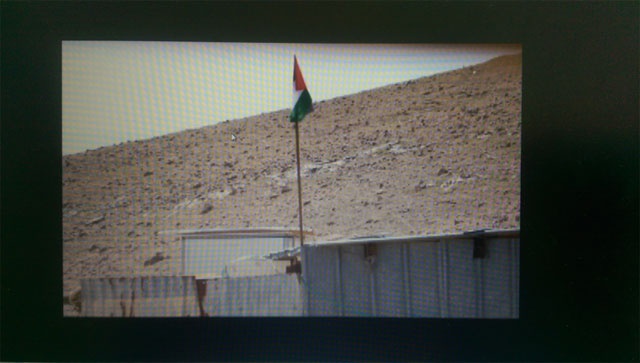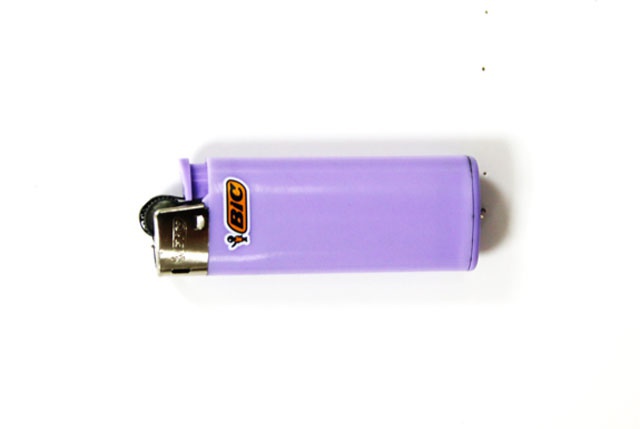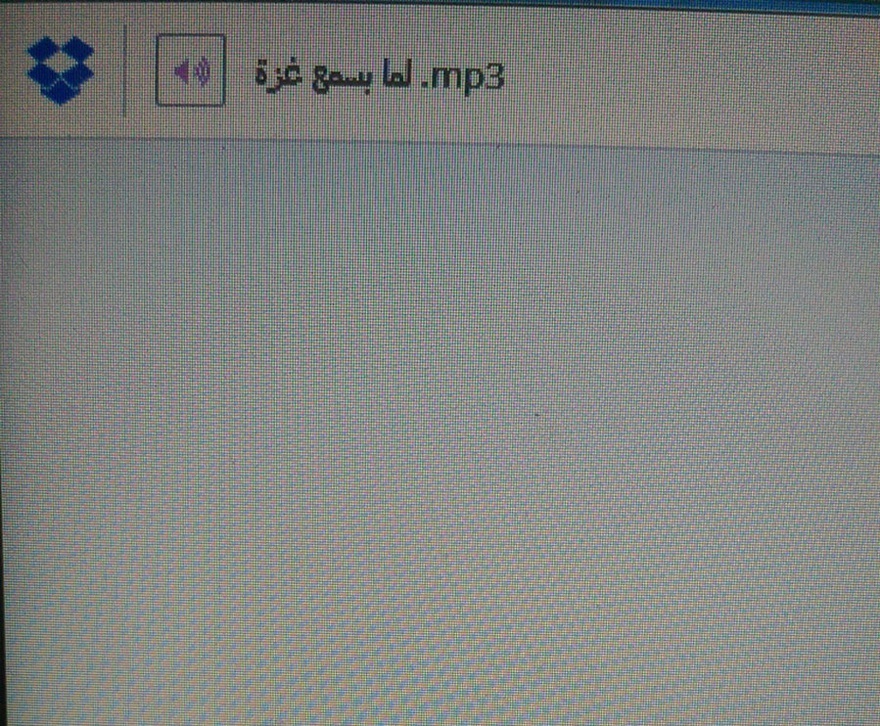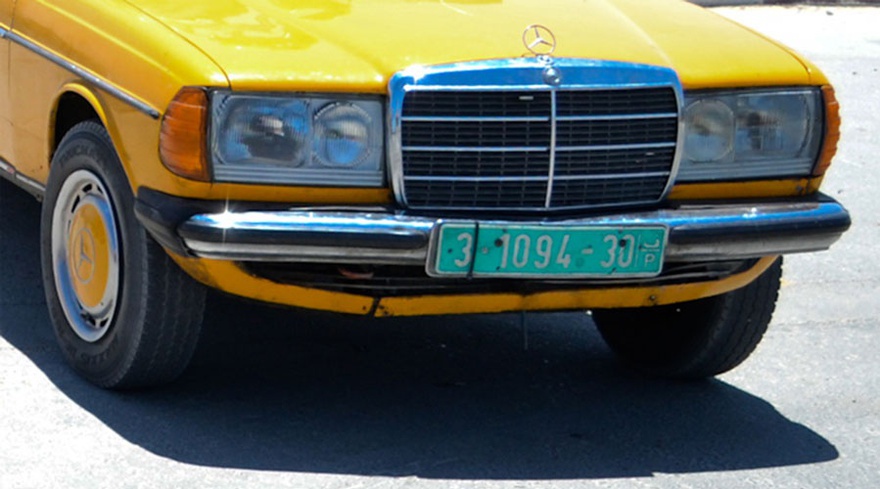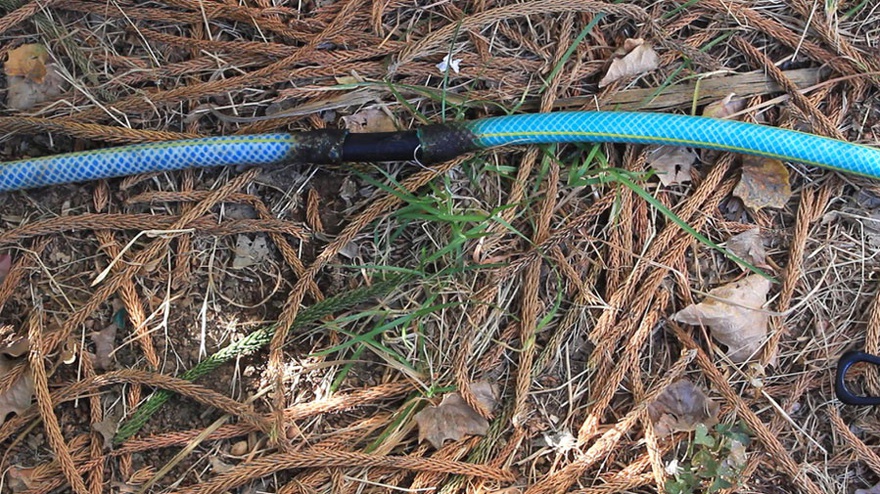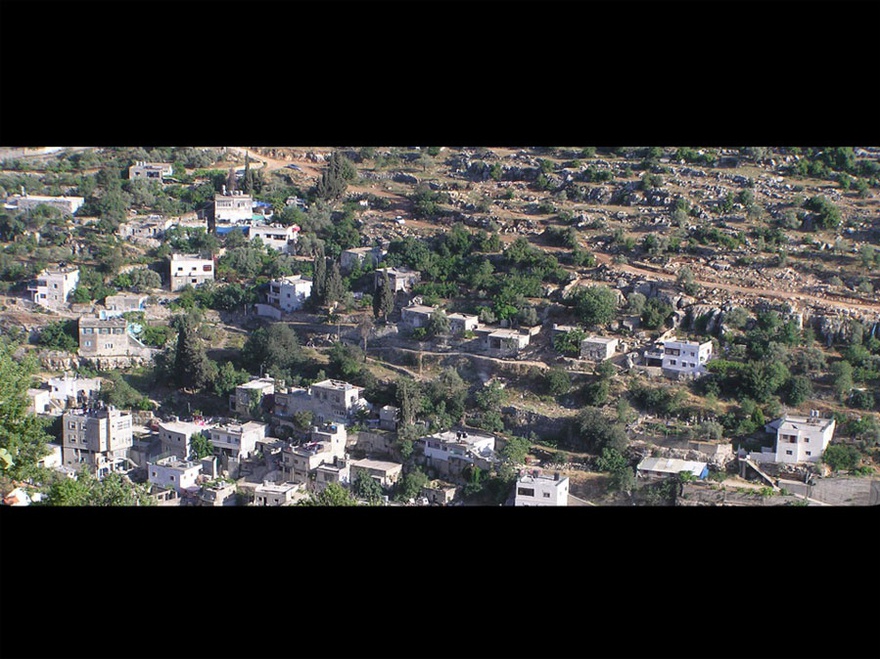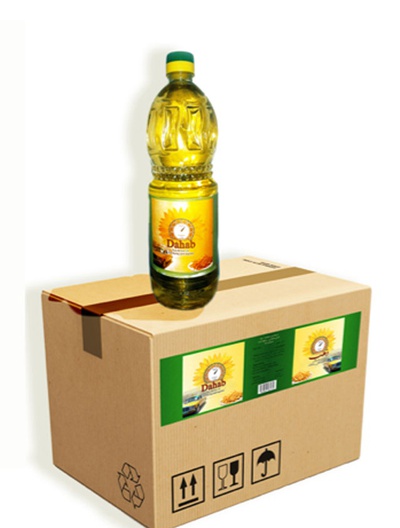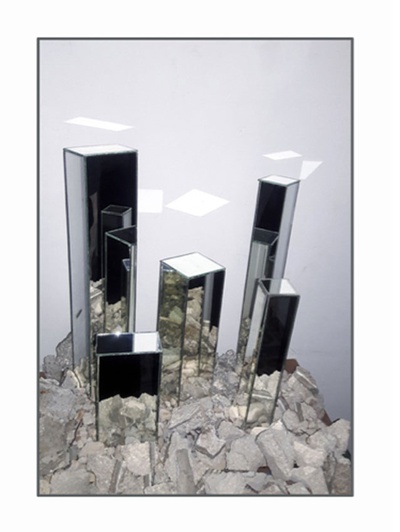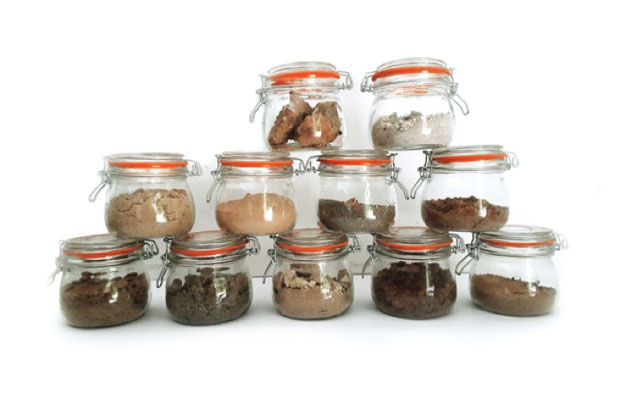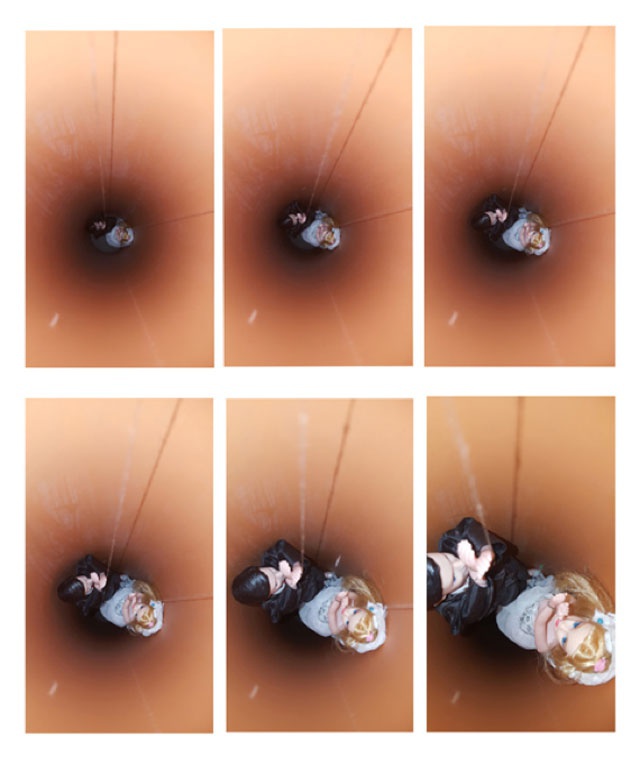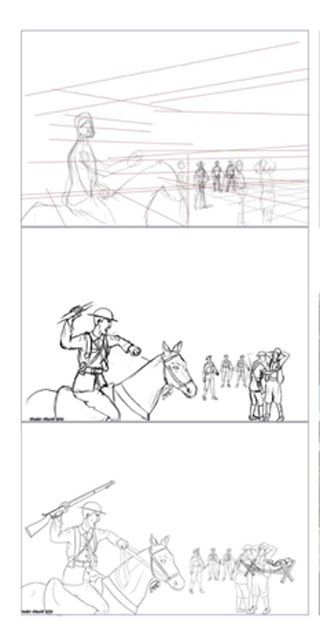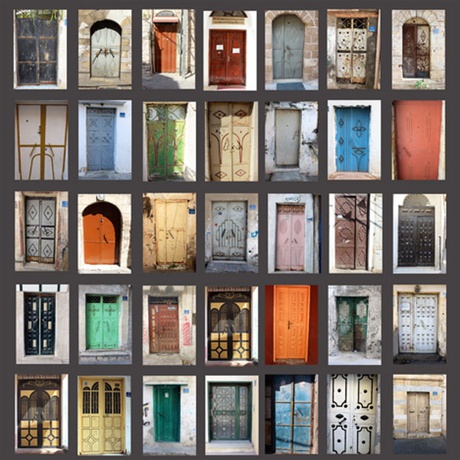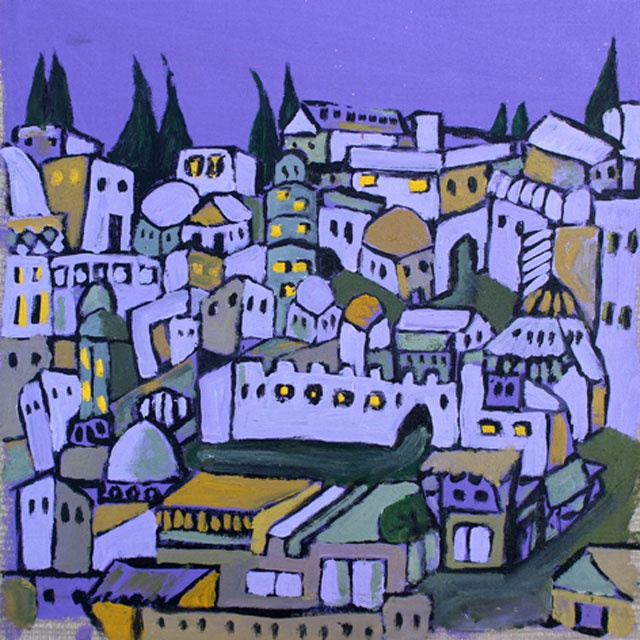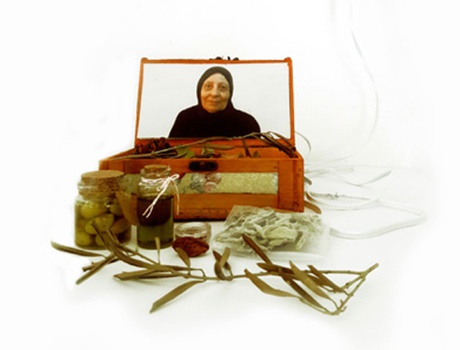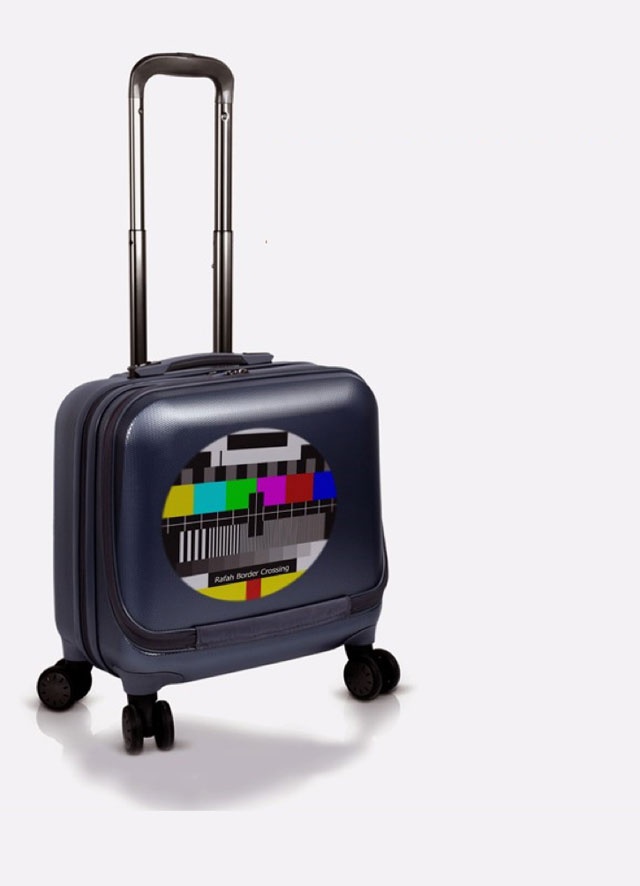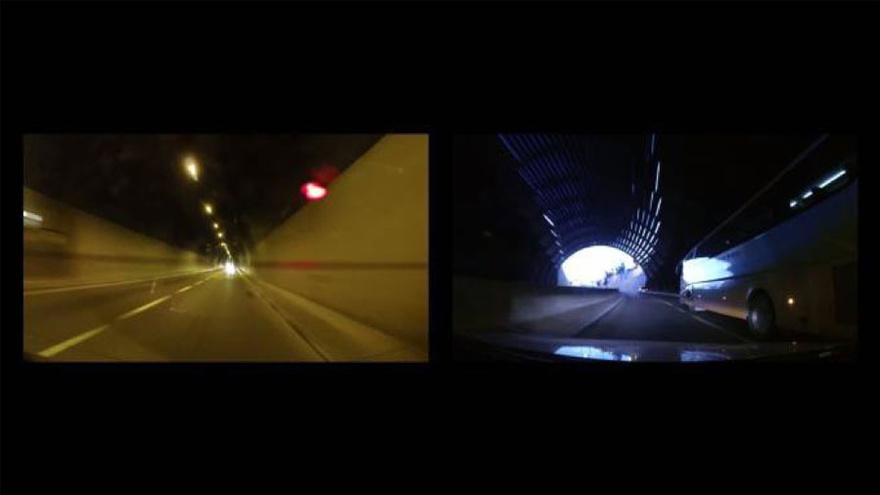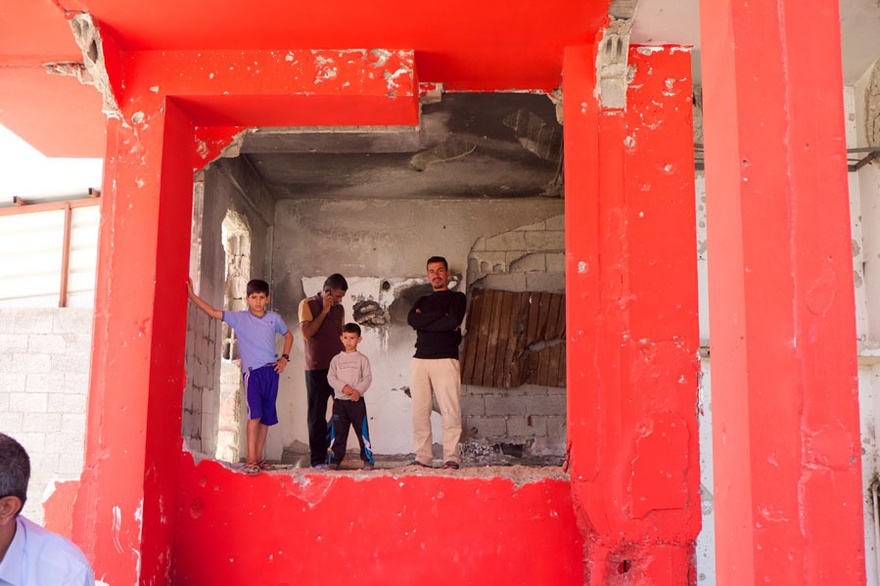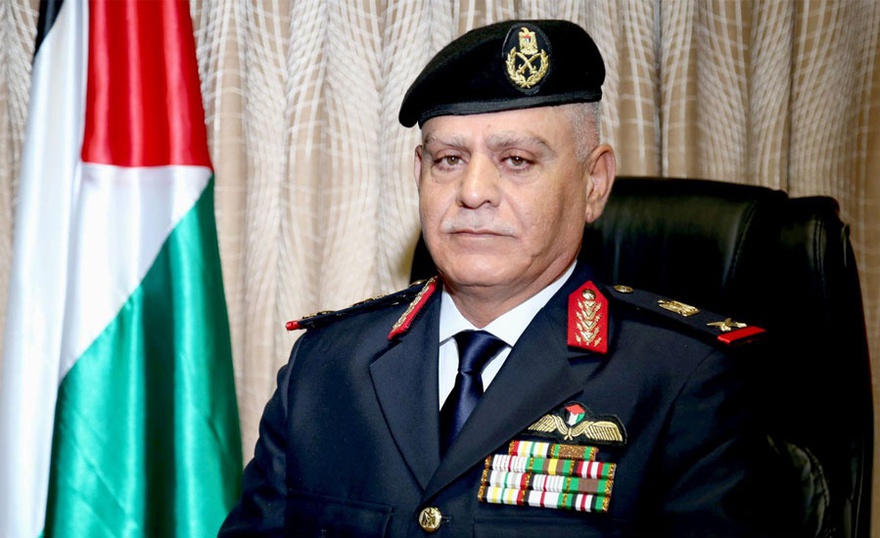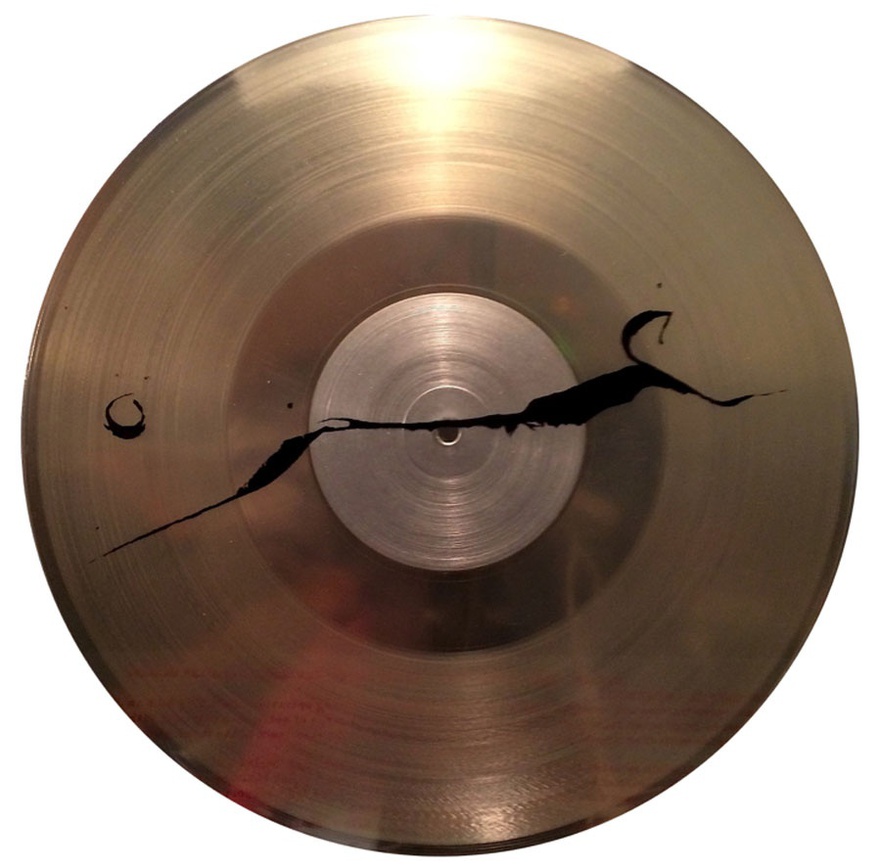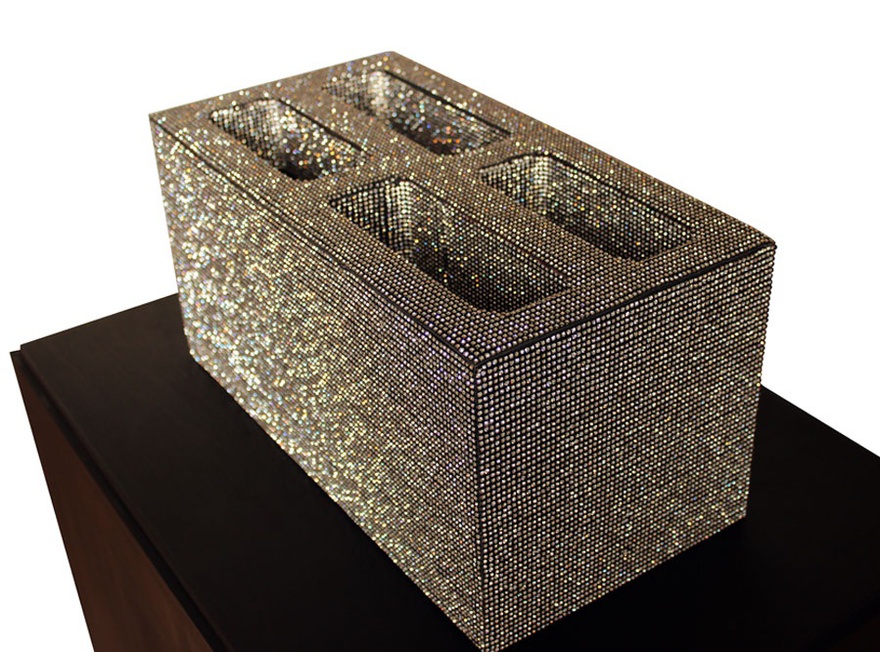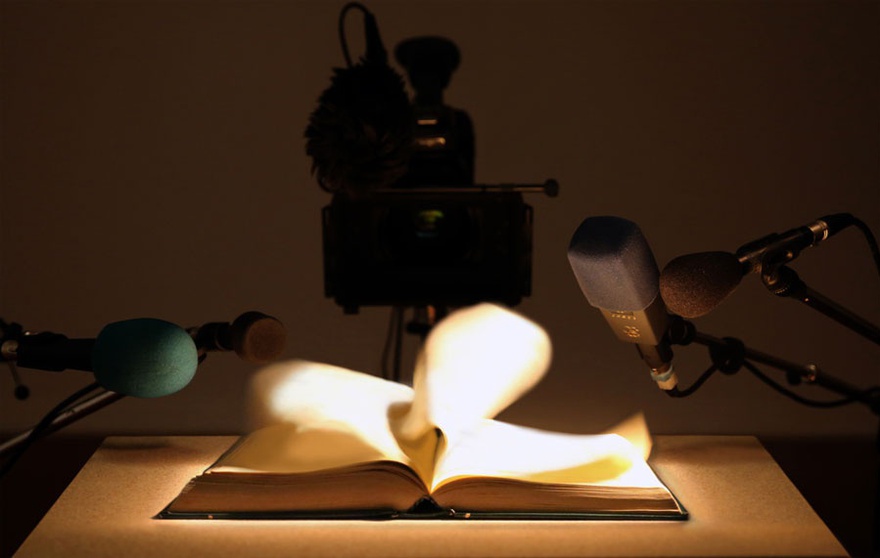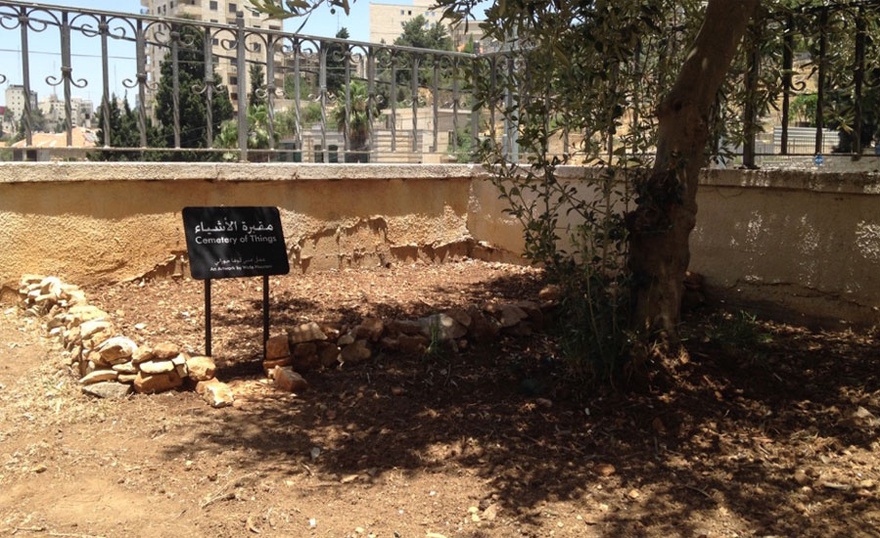Publications
Qalandiya International 2016
Cities Exhibition 5, 'Gaza – Reconstruction': Ramallah
Cities Exhibition 5, 'Gaza – Reconstruction'
Location: Ramallah
Venues: Daraj Gallery & Main Gallery, Birzeit University Museum, Ramallah.
Dates/Times: Open daily from 9:00–16:00, except Friday & Sunday. Runs through 31 October, 2016.
Organizers: The International Academy of Art Palestine, in collaboration with Birzeit University Museum and the Dept. of Architectural Engineering, Birzeit University
Commissioned Curators: Mohammed Al-Hawajri, Nasser Golzari, Group28 (Lana Judeh & Yara Saqfalhait), Ramallah Cinema Club (Salim Abu Jabal), Rula Khoury, Yara Sharif, Tina Sherwell.
Curator: Yazid Anani
Artists: Click on the names below to visit each artist's section
Chapter I
Participating students from the International Academy of Art – Palestine & from Dept. of Architecture – Birzeit University, Fadel Al Marbou & Taline Saliba, Noor Abu-Hashhash, Aseel Khalalieh, Amneh Khreis & Navef Zayed, Suhair Jarayseh, Wissam Sharabati, Adele Jarrar & Haneen Odetalla, Amani Yaqob, Dalia Boukhari, Hamza Amleh, Yusor Hamed & Lara Hodaly, Claudia Turton, Dean Robinson Van Der Vord, Victoria Thong Jiahui.
Chapter II
Amneh Khreis, Sondos Mlaitat & Suhair Jarayseh; Fadel Al Marbou & Taline Saliba; Aseel Khalalieh; Yusor Hamed; Hamza Amleh, Noora Said & Waseem Fouad; Hadeel Qutna & Abdulraheem Mohammad; Doa'a Saad Said Qeshta; Manal Hammad Eldeep; Amera Jamal Hamdan; Hala Hesham Abu Nahla; Khader M. Alkurdi; Moeen Al Sousi; Mohammed Imrany; Sharifa Al Gussain; Somaya Reyad Khalil Alaqra'a; Rabia Salfiti, Muhhamad Jabali & Rula Khouri.
Chapter III
Daar and Studioazue, Khaled Jarrar, Oraib Toukan, Ghazi Barakat, Mohamed Abusal, Nida Sinnokrot, Wafa Hourani.
Click on the links below to visit each section
Curatorial Statement by Yazid Anani
Foreword: One More Time, One Step Further…, Inass Yassin, Director | Birzeit University Museum
'We shall squeeze you empty, and then we shall fill you with ourselves.'
– George Orwell, Nineteen Eighty-Four, 1949.
The 5th Edition of the Cities Exhibition is an inquiry into the recurrent notion of destruction and reconstruction as a systematic reinstitution of societies and subjugation of local modes of resistance. Gaza – Reconstruction questions whether the inevitable economic doctrine of reconstruction complements the perpetual Israeli military destruction of Gaza, by removing what is left of its social sphere and resilient communities and replacing them with a neo-corporate Gaza. It investigates the dichotomy between the Palestinian political imagination of Gaza and the notion of reconstruction-in relation to multiple dynamisms and global and regional politics, the creation of new spaces for a transnational neoliberal economy and global financial structures, the transformation of the Palestinian liberation project, the lack of intellectual and cultural imagination of post-liberation Palestine, and, finally, the dis/junction of the Palestinian archipelago.
The 5th Edition of the Cities Exhibition is in four consecutive chapters, commencing in September 2015 and spanning until spring 2017.
Chapter I – Research from Afar
Student-based research on the reconstruction of Gaza. Students have examined their position as researchers vis-à-vis the notion of a remote inquiry about Gaza. How can one investigate an inaccessible place? How can we read the mass-produced images on Gaza after the Israeli assaults? Are we entitled to suggest authoritarian propositions of fixed solutions for both the destruction and reconstruction of Gaza?
Chapter II – Extended Geography
Chapter II is a collaborative research between artists, curators and students, investigating Gaza throughout Palestine's extended geography, covering the Gaza Strip, 1948 Palestine, the West Bank and Jerusalem. The inquiry of this chapter examines the notion of reconstruction as an issue that transcends the territorial demarcation of the place, whereby other comparative historic and contemporary examples can be probed. These collaborations follow a methodology of paths, trips and travels in the Palestinian archipelago in pursuit of an inquisition on the reconstruction of Gaza.
Chapter III – An Eye from Outside
A group exhibition showcasing the works of seven artists (Mohamed Abusal; Gazi Barakat; DAAR with Alessandro Petti, Sandi Hilal and Studioazue; Wafa Hourani; Khaled Jarrar; Nida Sinnokrot; Oraib Toukan) and encircling a central discursive forum where film screenings, talks and readings curated by two collectives, Group 28 (Lana Judeh & Yara Saqfalhait) and Ramallah Cinema Club (Salim Abu Jabal), are programmed for the duration of the exhibition (three months).
Chapter IV – Book of Re-Construction
Gaza – Reconstruction is an edited publication that accommodates the research material, and all the works produced in the three aforementioned chapters. The book is an assemblage of academic articles, artwork, research, documentation and images compiled since the inception of the project in September 2015 until the opening of the exhibitions in October 2016.
One More Time, One Step Further…
Inass Yassin
Director | Birzeit University Museum
Birzeit University Museum presents the 5th edition of Cities Exhibitions: Gaza Reconstruction, as a signifcant experience that offers the interactive platform for cultural practitioners to work together in spite of borders, barriers or their different geographic locations. This edition of Cities Exhibition reveals a new important dimension of the relationship between cultural practice and the production of knowledge, which is the main theme across the different exhibitions produced & curated by the Museum; such that it's a basis for a number of partnerships with individuals and institutions. Since we started the work on the exhibition in in September 2015, a number of artists, cultural practitioners, university students and field researchers took part in realizing the different components of the exhibition, which will continue until February 2017.
This edition will present group artist exhibition along with students show at Daraj Gallery; a new art space that engages students in artistic production processes. In addition to a group show in Gaza.
Participating students from the International Academy of Art – Palestine:
Abdallah Abu-Soud, Abdelraheem Mohammad, Amani Harhash, Amani Yaqob, Dalia Boukhari, Hadeel Qutna, Hamza Amleh, Lara Al-Shroof, Lara Hodaly, Lubna Al-Araj, May Mari, Noor Abu-Hashhash, Reem Masri, Tuqa Al-Sarraj, Waseem Makhlouf, Yusor Hamed.
Participanting students from the Department of Architecture – Birzeit University: Abdulmajeed Al-Hindi, Amneh Khrais, Aseel Khalaileh, Fadel Al-Marbou, Isra Harfoush, Michael Jabareen, Nayef Zayed, Sondos Mlaitat, Suhair Jarayseh, Taline Saliba, Wissam Sharabati.
Animated Gaza
A series of animations produced by the students of the IAAP and Birzeit University Department of Architecture, that probes issues on disconnection, stereotypes, and the problematics of the current project of reconstruction.
Fadel Al Marbou & Taline Saliba
Alternative History of Gaza
This project searches in Gaza's history, but not in an ordinary linear way, but in a network-like way which connects a space with an event, a person with an object, a narrative with an entity. However, this historical research questions the legacy of imperial power in the city's past, while dismantling its colonial manifestations through the local appropriation of its physical markers.
Gaza Cube
Following the Israeli aggression on Gaza and what it left of massive destruction, and tens of thousands of homeless people, who lacked the minimum elements of a decent life after they lost their homes and property, which the aggression made of it a rubble of devastation and memories, a donors' conference for the reconstruction of Gaza was held. Years have elapsed after holding this conference with what it carried of hopes and promises. Nevertheless, the long months that followed the conference carried with them only confusion, uncertainty, and doubt about the seriousness of this project, and the complexity which is maze-like and difficulty to get out of it. This motivated me to reflect this complexity, mystery and sense of helplessness in an art project that takes Rubik Cube technology a shape for it, but solving its puzzle seems more difficult. This is because the issue is not simply related to assemble parts of the same color on one surface of that cube; it is much more complicated than that.
It is a future imagination for a mobile community was designed and thought out based on the official discourse of international institutions and many countries participated in the Cairo Conference on Palestine: Gaza reconstruction 2014. Mobile society that resulted has his independent governmental and economic axis e and has the freedom to move in the extended geography of Palestine.
De/Re-construction
How do we imagine Gaza once it is rebuilt? A question that has arose a lot lately, whether it may be by politicians, economists, humanitarians, and architects alike. Gaza has suffered for the past years greatly, image of destructions are the only things we see. Gaza has been destroyed and re-built over a dozen of times. In this project, this project suggests a new typology of architecture, a typology defined by the destruction of Gaza. Looking at the destruction, we can still see buildings that are either partially or fully destroyed. Those who are partially destroyed, their units can be recycled and used again to produce a new type of architecture, a Gazan architectural style. Many images were collected of such parts and units and tried to combine them into a new building in order to see what the outcome could be. Could this be what the reconstruction of Gaza really is? Is this brutal tobography can develop to a new architecture school?
The Aesthetics of Destruction
Aestheticizing destruction has become a global phenomenon, from the high culture to the pop culture such as in media, art, literature, poetry, film making...etc. It has become a fashionable commodity for culture. Wars and revolutions have become a fetish for cultural practitioner and a wave to ride whereby aestheticizing trauma and violence is innate to the core of cultural commercialism.
The notion depicted in this project refers to cultural production in times of war vis-à-vis the sterile aesthetization of its atrocities. Hereafter, architecture is viewed as a practice that can fall into this category, whereby the project suggests a satiric initiation of a school of architecture that abuses the destruction of Gaza as a creed for its stylistic approach. This school of Architecture which is entitled "the aesthetics of destruction" would eventually contribute to the project of 'Reconstruction of Gaza' and its visual culture.
Adele Jarrar & Haneen Odetalla
Architecture, power, and identity
This project is not a solution for Post-War Gaza; it is rather a visual analysis, research, and experimentation with architecture as a product of different political ideologies.
The Everyday Wall
Palestinian society is becoming an emerging neoliberal society that have been formed during the last two decades, which made huge changes and shifts are impossible to ignore.
This project draws attention on how corporations are affecting us consciously or unconsciously, trying to form a collective taste that shares the same picture of what we all should be or look like, by linking between our consumption and social position.
Floating bricks
Light, space, and gravity are major components in the work. It is a delicate material and subject matter tackling Gaza reconstruction. To me, the fears and hopes of so many hang within that floating space. An essence of the ongoing destruction of Gaza and the ongoing planning for THE RECONSTRUCTION OF GAZA…
Commodity Infiltrates
I've been thinking about you since a really long time... I've been waiting for you, and imagining you during my nights. I am dying to reach you. All I need is a touch, a really tight hurtful touch. Maybe a bite. I long to infiltrate it as deep as I can… to hit your sensitive organ as hard I can. hmmm! When I catch you, I will show you how it is supposed to be.
The Great Joy
Loan crisis in Palestine is caused by the quest to achieve the great joy through purchase of a house and a car to show up a social illusive status that makes the employee a slave for the banks. He/she has to work day and night to repay the due loan. We embodied this idea by designing exciting dresses to symbolize the required social status and raise questions regarding the need and the desire.
Take Off
Take Off uses the airport of Gaza as its central focus. The airport was one of the only ways for those trapped to leave the strip, but it was destroyed three years after opening. It is always at the forefront of any negotiations between Gaza and Israel. The air and sea connect land anywhere in the world, but this doesn't have a stronger significance to a country's people than in Gaza. The restrictions placed on the land mean that any connection to the outside is sacred.
My project takes the concept that airports are on the other side of the border, and governed by international law. This creates a free space, a sanctuary outside the occupation. ! While Palestinians wait for the airport to gain permission for takeoff, the people of Gaza can fly in wind tunnels, giving them the experience of flight – a feeling which would be desirable in any part of the world.
Agrarian Arcadia: The lot Palestinian Utopia
This thesis is a polemic against the shifting 'buffer' and 'no-go' zones, which in 2014, covered over 40% of the Gaza Strip. To subvert the siege, focus is on empowerment via self-sustainability; with attention on the security of food and water resources. By reclaiming the agricultural lands that are within these high risk zones, short term reliance on the border is eased while an epic strategy is prepared.
The project's ambition is to implement a new collective socialist structure that contrasts current fascist oppression. Parallels with other societies are drawn to support the project, such as: the Soviet Union's collectivisation of its 'Kolkhoz' farms, and Israeli utopian 'Kibbutz'.
Altering the landscape also brings into question the role of the Palestinian landscape as a symbol of national identity. A subject at the core of historical and current socio-political tension. The mechanical fields become a palimpsest for the polemic, reflecting the tenacity of Palestinian people.
Mamilla National Park
A Landscape of 'Lost Property
As a response to the controversial Museum of Tolerance built by the American-Jewish Simon Wiesenthal Center (SWC) on the ancient Mamilla Cemetery, the project proposes a series of archives, libraries and museums to recreate a 'landscape of lost property' dedicated to generations of Palestinians in the West Bank and diaspora abroad, symbolically returned to the heart of Jerusalem; where they cannot be.
Designed as a flooded landscape, the project gains greater poetic meaning as a reflection on the incredibly vulnerable socio-political fate of the Palestinian state. Water; fluid/ neutral is the antithesis of territory/ terra firma, a concept which has lost all physical and symbolic meaning in the Palestinian situation. The theme of vulnerability permeates the scheme and becomes the overarching design intent in the cemetery where even in death, one can never return to a permanent resting place or home.
Chapter II
Amneh Khreis, Sondos Mlaitat & Suhair Jarayseh
This movie links the work of the classical French painter Nicolas Poussin whose paintings were inspired by the biblic stories of Jews and Filistinis, and images of the destruction and displacement of Gazans, and Bidouins in West Bank.
Fadel Al Marbou & Taline Saliba
When I hear Gaza؟
It is a street investigation on people's thoughts and knowledge of Gazans' life and the reconstruction projects of Gaza, then providing a future image of a united Palestine consisting of Gaza and the West Bank according to the imaginations of the people investigated. This is done in a systematic manner giving every person a number in order to answer the questions.
Gaza Travels
Return to my childhood, which is connected with Gaza and my frequent trips from Ramallah to Gaza with Gaza Travels Office. It is also about my talks with my Gazan grandmother who used to receive me at Beit Hanoun crossing. For this purpose, I searched for Abu Salim, the owner of Gaza Travel Office and talked with him about the trips from his office located in Rukab Street in Ramallah to Beit Hanoun crossing.
Hamza Amleh, Noora Said & Waseem Fouad
Hose by hose
Groundwater in the Gaza Strip contains large amounts of Nitrogen and Chloride, making 90-95% of that water contaminated for drinking usage. Moreover, the groundwater is not even pure for irrigation. Due to this reality, a large-scale project, the hose project, was proposed. The hose project suggests the participation of the hoses of the West Bank Palestinians, which are used for their home-garden irrigation. It is preferred to collect as many hoses as possible, since the main objective is to connect the hoses to one another. When the connection of hoses is done, the huge resulting hose will begin to function as a water transferer. The final hose will transfer clean drinkable water from the houses of the West Bank Palestinians to the houses of Gaza Strip Palestinians. The hose project is a convenient proposal, since it takes into consideration the cost and complexity of its implementation. Finally, most importantly, the hose project aspires to enhance the collaboration between Palestinians from the West Bank and Palestinians from the Gaza Strip.
Hadeel Qutna & Abdulraheem Mohammad
Foray
This artwork creats a Parallelism between the daily trips from Ramallah to Qebya, in which Palestine was subjected to over time, under the current crisis that Gaza and its cities suffer from and the tight siege imposed by the Israeli occupation. Being a vital area and a passage to the world, a question is raised: Has Palestine become in need to passages to connect it with itself?
The Seven Wonders of Gaza
The Seven Wonders of Gaza project presents the many circumstances which Gaza currently experiences. I wanted to highlight the oppressive siege imposed on Gaza. In my work, I spoke about the cut off of fuel and the resulting crisis of transportation when some drivers were obliged to use the cooking oil as an alternative to move their vehicle. This idea succeeded and oil salesmen replaced the fuel stations.
Gaza Tunnels
Rafah is one of southern Gaza Strip cities. It is closely connected with Egypt due to its location in the vicinity of borders. Rafah is famous of its tunnels that have been digged during the siege period. Youth has make weddings down there after they lost hope. Speaking about marriages via the tunnels is not strange in south Gaza. Freedom of Travel and mobility cannot be separated from the human dignity.
Gaza, the Past the Present
I've noticed that the past is often handled separately from the present and vice versa, especially in artworks. Hence, the idea of merging the past and present together in one artwork through which I reflect the originality of the archeological building came to my mind. Thus, I chose Al-Basha Palace as a starting point for a series of works I intend to accomplish in the future. For this purpose, I took a photo of the palace. Then I imagined a historical event happened or may have happened for this archeological building. The event I chose was the Great Palestine Revolution during the British Mandate. I imagined a check point placed in front of the palace, which was used by the British as a police center. I intentionally avoided exaggeration about history so as to be convincing for the spectators and focus on the artistic value of the work.
A house is known by its door
Door decoration gives an impression about the social status of the people living in the house. This artwork displays doors to give metaphysical dimensions and open up other worlds … wide … beautiful or full of questions. My artwork is connected to time where capturing a photo has a particular event that imposes itself when we knock on the door of the house or smell its scent.
There is no doubt that the door in our lives is the gate to enter or leave the place of residence, workplace or a building we constantly visit.
Gazan Architecture
In the old times, construction of houses were distinguished with their non-straight lines and sometimes zigzags, which suggest simplicity and lack of affectation and gives you feelings of calmness and tranquility. Nowadays, lines of buildings on the exterior surface differed and decorations varied. Lines became straight, sharp and more solid. Such kind of construction makes us more formal in our relations with each other and created different classes of people. Moreover, the shape of lines has the greatest influence on soul and spirit.
The idea of the project explains the depth of feeling of the structure of lines and shapes, their differences and evolution from generation to generation and their strong relation with the culture of the society and surrounding environment as well as their influence by the outside world and the eras that Gaza city went through and its architectural development. The work shows the image clearly and explicitly in a simple artistic style with high transparency.
Nostalgia Music
The project is a conversation with my grandmother recorded with music from a music box in the background, The box has been redesigned, and a small sculpture of Jules has been put in the middle of it. The viewer will listen to music from the box and to the voice of my grandmother as she described the beauty of Jules.
Article 13
Article 13: A movie poster that mimics the right of people to full freedom of movement and travel, highlighting one of the most humanitarian issues in Gaza Strip. The poster of this imagined film tries to restore the ancient past of Gaza and bring life to cinemas, which have become deserted places and nothing is left of them except their names.
Rabia Salfiti, Muhhamad Jabali & Rula Khouri
Son? Are you ASLEEP?
Can we travel in space without a narrative? Can we travel without a time perspective? Can we travel without telling stories?
Landscape is probably one of the things we would like to think about as the total neutral... but is it neutral? Does landscape exist outside of our perception? Why do we tell children stories when we take them on a travel? How do we explain to them what we are seeing?
But have we ever told the story of the holly lands without this layer of medieval struggle between west and east? Have we ever succeeded in scrutinizing the story into a struggle against colonialism? A struggle of national liberation? Didn't we always tell our children stories of a far history when we traveled this landscape?
Return to Gaza
Reconstruction is often imagined as being the counterpoint to destruction. While the two are often seen as opposite moments, in reality these moments are linked in a cycle. Since 1948 Palestine has been constantly destroyed and reconstructed. It is within the limitations of intersecting force fields of destruction and reconstruction, displacement and return, refugeehood and citizenship, informality and formality, public and private that in 2016, DAAR and Studioazue were commissioned by the Italian Agency for Development and Cooperation to produce a reconstruction plan of Al Nada Neighborhood in close collaboration with the technical team of the Ministry of Public Works and Housing. The objective of the project was to rehabilitate the still standing 386 residential units partially damaged during 2014 and previous attacks and to construct 207 additional housing units and regenerating urban infrastructures and open spaces. The community-based master plan involved the Al Nada and al Isba Neighborhood Committee, Beit Hanoun Municipality, Joint Service Council for the Northern area, families and individuals.
Hanging Plane
At noon of 11 May 1995, corresponding to 24/12/1415 Hijri, was the first flight over the Palestinian territories of the Presidency Helicopter of late President Yasser Arafat (Abu Ammar God have mercy on his soul).
On 7 December 1996 corresponding to 27/7/1416, the first journey by air in Palestinian planes, the Russian-made helicopter Mi-17 Presidency helicopter, carrying late President Arafat, took off from the Presidency runway in Gaza to abroad.
It is a documentary examining through the diaries of Russian-made helicopter Mi-17, which flew in the air for a limited period of time, the issues of political dominance by monitoring the Palestinian geography with Palestinian eyes. This work investigates the great contradiction between land and air crossing and between air flight the aircraft as a structure symbol of sovereignty erected for military trainings in an attempt to revive it through broadcasting the voice of the helicopter with loudspeakers.
n/a
For Cities Exhibition, Toukan revisits images that were transmitted from screen to screen in the summer of 2014, and have since, been difficult to 'un-see'. The work involves hours of audio conversations via Skype with the photographers, drivers, and fixers who originally captured them- two years on and a few cities away.
Gaza
The two sides of this record are about a place like no other on this planet, a city and its surrounding environs living under extraordinary conditions, hermetically sealed from all sides, only accessible through complex procedures and permits, making it is almost as difficult to get in as it is to get out. Like a cross between the Warsaw ghetto and Manhattan as a giant maximum security prison in John Carpenter's Escape From New York. Every couple of years the Gaza Strip gets its share of bombardments, and since the summer of 2014, its infrastructure has been pulverized almost to the point of no return. The disproportionate use of force and the asymmetric use of military technology on those already living under siege has created a field laboratory for the military industrial complex with the civilian population as its guinea pig.
The Precious 20 cm Stone
20 cm building stone coated with crystals similar as to diamonds inside a glass box on a black display window. The building stone in the bombed houses is sold for a higher price than normal because of the lack of cement for manufacturing new stones.
Stone: 40 cm length * 20 cm width * 20 cm height.
Display Window and glass: 130 cm high * 60 cm length 42 cm width
Exquisite Rotation
In Exquisite Rotation an open copy of a bound and illuminated manuscript sits atop a lectern, surrounded by an array of broadcast media technologies and two oscillating fans. Lit from above the book's pages turn, at times with hesitation and at times, whipped and thrown, in a ballet of illumination. A live image of this orchestrated riffling fills the space with ethereal and mesmerizing effect, heightened by the amplified crackle of the pages and the low droning of the fans. All interpretation follows from the tension that ensues.
Through tactical acts of technical and conceptual détournement, much of Nida's work subverts various technologies of control: surveillance, cartography, weapons, mechanical/digital image (re)production, and their implicit interactions with actual spaces and the bodies that move through them. Though tactile experimentation Nida tries to anchor those tectonic systems that continue to give rise to shifting social political and geographic instabilities.
The graveyard of secrets
'Nowadays secrets are most powerful than images in art'
As much as an image that catches the moment embraces the meaning of creation (becoming), art expresses itself that is hidden from us and in us as if it is a refugee, just like us in reality. After thought was enclosed with boundaries of responsibilities, is there a field that nurtures our rights and illusions other than images and verses of poetry? In other words, the need for detachment on one hand, and the innovation of different ways to depict life, the future of expression and the essence of art as a travelling renewable science to portray disappearance (vanishing) ahead of its time (before getting there). If this had to be, let be there a grave for the secret and let the grave be the witness for the essence of ambiguity and the future of disappearance; let us bury our secrets as our martyrs; thus art would become the graveyard of things, a holy and eternal graveyard. The spectator would then remain staring at the invisible in us and would not see but his own secret that he would disclose to himself and think of another.
This substantial work would not have been possible without the passion and endeavor of the exhibition curator, the artists, initiators, individuals & collectives, participating students and the BZUM team.
This project is supported by AFAQ: the Arab Fund for Arts and Culture, Rosa Luxemburg Foundation- Regional Of ce Palestine, CKU: centre for culture and development and DHIP: Danish house in Palestine. And in partnership with: A. M. Qattan center for the child, Gallery One, and Ihouse. And in collaboration with Architecture Department at Birzeit University, International Academy of Art - Palestine, DAAR: Decolonizing Architecture Art Residency, Eltiqa Group for Contemporary Art, Qalandia International, Group28, Studioazue, Ramallah Cinema Club, Westminster University

